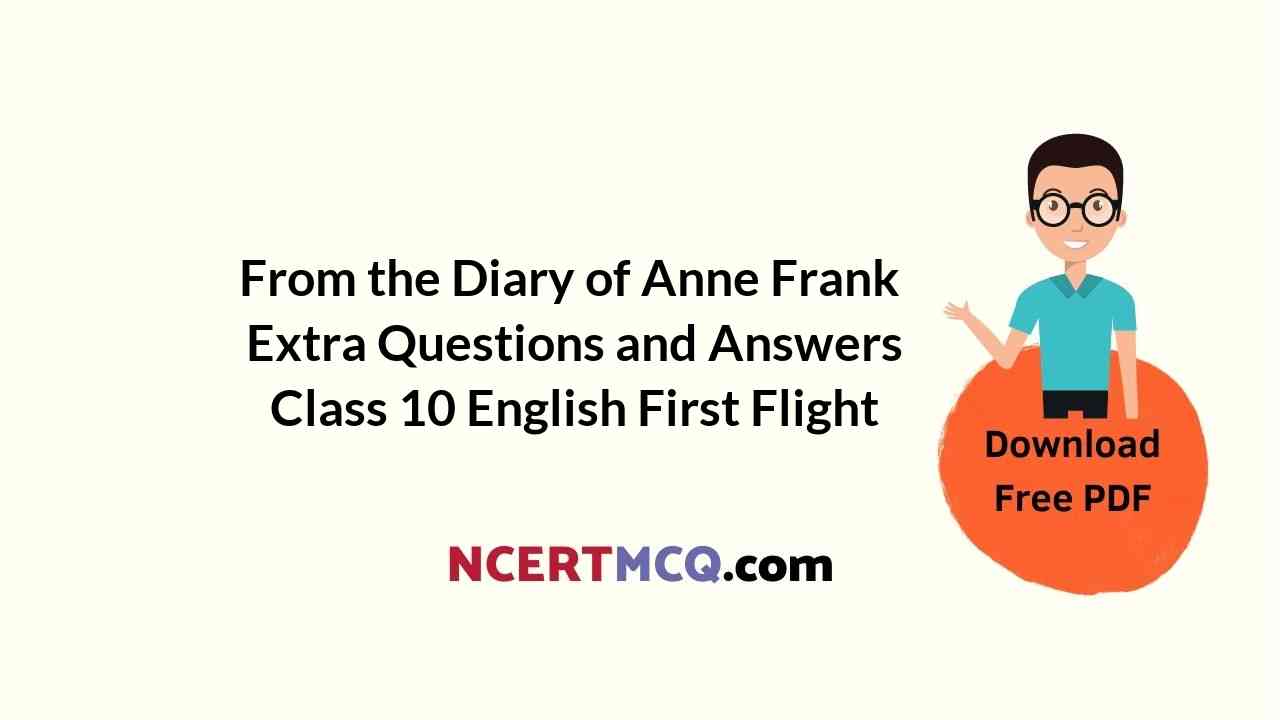Here we are providing The Hundred Dresses Part 2 Extra Questions and Answers Class 10 English First Flight, Extra Questions for Class 10 English was designed by subject expert teachers. https://ncertmcq.com/extra-questions-for-class-10-english/
The Hundred Dresses Part 2 Extra Questions and Answers Class 10 English First Flight
The Hundred Dresses Part 2 Extra Questions and Answers Very Short Answer Type
The Hundred Dresses Part 2 Extra Questions And Answers Question 1.
Where did Wanda live?
Answer:
Wanda lived at Boggins Heights.
Hundred Dresses Part 2 Extra Questions Question 2.
Where would Peggy and Maddie wait for Wanda?
Answer:
They would wait for Wanda in the school yard.
Extra Questions Of The Hundred Dresses Part 2 Question 3.
Why would they wait for Wanda?
Answer:
They would wait for Wanda to have fun with her.
The Hundred Dresses Part 2 Extra Question Answer Question 4.
What would Peggy ask Wanda?
Answer:
Peggy would ask Wanda how many dresses she had.
Extra Questions Of Hundred Dresses Part 2 Question 5.
Why did Maddie call herself coward?
Answer:
Maddie called herself coward because she never stopped Peggy from making fun of Wanda.
The Hundred Dresses Part 2 Questions And Answers Question 6.
What did Maddie want?
Answer:
Maddie wanted to find Wanda.
Hundred Dresses 2 Extra Questions Question 7.
What did she study intently?
Answer:
She studied the drawings intently.
The Hundred Dresses Part 2 Short Questions And Answers Question 8.
Who made the pictures on the walls of Room Thirteen?
Answer:
Wanda Petronski had made the pictures.
The Hundred Dresses Part 2 Extra Questions and Answers Short Answer Type
Hundred Dresses Part 2 Important Questions Question 1.
What did Mr Petronski’s letter say?
Answer:
Mr Petronski’s letter said that Wanda would not come to school anymore. Now they were moving to a big city where no one would ask about her funny name.
The Hundred Dresses 2 Extra Questions Question 2.
Is Miss Mason angry with the class, or is she unhappy and upset?
Ans.
Miss Mason was not ahgry with the class. She only looked upset. She was not happy with the incident.
The Hundred Dresses Part 2 Important Questions Question 3.
How does Maddie feel after listening to the note from Wanda’s father?
Answer:
Maddie feels very sad. She could not put her mind to her work. She had a very sick feeling in the bottom of her stomach.
The Hundred Dresses Part 2 Extra Questions Question 4.
What does Maddie want to do?
Answer:
She wants to tell Wanda that she had not meant to hurt her feelings.
Class 10 English The Hundred Dresses Part 2 Extra Questions Question 5.
What excuses does Peggy think up for her behaviour? Why?
Answer:
Peggy makes an excuse that she never called her a foreigner or made fun of her name. She says that she did not know that Wanda would feel hurt.
Class 10 The Hundred Dresses Part 2 Extra Questions Question 6.
What are Maddie’s thoughts as they go to Boggins Heights?
Answer:
Maddie was thinking that she would tell Wanda they were sorry for their behaviour and ask her not to move away as everybody would be nice to her.
Hundred Dresses Part 2 Question Answers Question 7.
Why did Mr Petronski write a letter to the school teacher?
Answer:
Mr Petronski wrote a letter to the school teacher because the students of her class made fun of Wanda’s name and dress.
Question 8.
What did Peggy and Maddie want to say to Wanda after meeting her?
Answer:
Peggy and Maddie wanted to say sorry for their behaviour. They hoped that Wanda would not have left the school/city and they would meet her at Boggins Heights.
Question 9.
What happened when Maddie and Peggy recognised Wanda’s house?
Answer:
There was no one in the house. Peggy knocked at the door. But she could not get any answer. Peggy repeated it but all in vain. After this they were confirmed that there was no one in the house.
Question 10.
What did the girls know at the end/last?
Answer:
Maddie and Peggy came to know that Wanda liked them very much. Wanda designed their faces in her dresses. Although they teased her, yet she loved them.
Question 11.
What did Mr Petronski’s letter say?
Answer:
Mr. Petronski wrote a letter informing the school that his daughter, Wanda Petronski would not come to school any more. They were moving to a big city where no one would make fun of her name.
Question 12.
Is Miss Mason angry with the class, or is she unhappy and upset?
Answer:
When Miss Mason came to know that the class had been making fun of Wanda Petronski’s name, she was both unhappy and upset. She was not angry but she was troubled to know the incident.
Question 13.
How does Maddie feel after listening to the note from Wanda’s father?
Answer:
Maddie had a very sick feeling in the bottom of her stomach. She could not put her mind in her work. She thought that she was as bad as Peggy because she never stopped Peggy from asking insulting questions from Wanda about her dress though she did not like that behaviour.
Question 14.
What does Maddie want to do?
Answer:
Maddie wants to tell Wanda that she never meant to insult her. She was sorry for everything. She did not want Wanda to leave that place. She wants to tell her that she was very much troubled over the incident.
Question 15.
What excuses does Peggy think up for her behaviour? Why?
Answer:
Peggy was also upset over the incident. She said that she had never called her a foreigner. She had never made fun of her name. She had never thought that she know were making fun of her. She thought she was too dumb.
Question 16.
What are Maddie’s thoughts while going to Boggins Heights?
Answer:
Maddie thought that she would find Wanda and on meeting her she would tell her that nobody would make fun of her name. The whole school thought that she was wonderful. If anybody made fun of her, Peggy and Maddie would fight with them. She would feel sorry and request her not to move from there.
Question 17.
Why does Wanda’s house remind Maddie of Wanda’s blue dress?
Answer:
Maddie and Peggy reached Wanda’s little house at Boggins Heights. The house and its little yard looked shabby but clean. It reminded Maddie of Wanda’s one dress, her faded blue cotton dress, shabby but clean.
Question 18.
What does Maddie think hard about? What important decision does she come to?
Answer:
Maddie was upset over the incident. She could not meet, Wanda. She came back but could not sleep that night. She thought about Wanda, her faded blue dress, the little house she was living in and the glowing pictures of hundred dresses. After the hardest thinking of her life, Maddie reached an important conclusion. She decided that she was never going to stand by and say nothing again. If she ever heard anybody picking on someone because they were funny looking or because they had strange names, she would speak up. She would never make anybody else unhappy again.
Question 19.
What did the girls write to Wanda?
Answer:
The girls wrote to Wanda about the contest and told her that she had won it. They appreciated her drawings. It was a friendly letter. They asked if she liked her new place and the teachers. They closed the letter with lots of love and wishes for Wanda.
Question 20.
Did they get a reply? Who was more anxious for a replay, Peggy or Maddie? How do you know?
Answer:
Weeks went by and still Wanda did not answer to Peggy and Maddie. After a long period of time, the reply was received by the school. Maddie was more anxious for a reply. Peggy had begun to forget the whole business. But Maddie did not forget Wanda. She used to make speeches about Wanda before going to bed.
Question 21.
How did the girls know that Wanda liked them even though they had teased her?
Answer:
In her letter to school, Wanda wished all the girls Merry Christmas. She offered all the hundred dresses to the girls. She gave the blue one to Maddie and the green one to Peggy. This shows that Wanda liked all of them though they always teased her.
The Hundred Dresses Part 2 Extra Questions and Answers Long Answer Type
Question 1.
What was Miss Mason’s reaction after reading Wanda Petronski’s father’s letter?
OR
Letter from Wanda Petronski’s father made Miss Mason and the students tense. Why?
Answer:
Miss Mason was in Room Thirteen. She got a letter from the principal’s room. It was from Wanda’s father. After reading it, she was very unhappy and upset. She looked at the students and spoke in a low voice that Wanda would not come to that school any more because the students made fun of her and hurt her feelings. On listening the letter the class became silent and Miss Mason called it an unfortunate thing. Maddie could not focus herself in studies. She was deeply hurt and sad. She was thinking to do something. She wanted to tell Wanda that she had never meant to hurt her feelings. She decided to accompany Peggy to see Wanda. There she would tell Wanda that she had won the contest. They would say that she was smart and her hundred dresses were beautiful.
Question 2.
How did Peggy and Maddie realise Wanda’s feelings that she liked them?
OR
What were the feelings of Maddie and Peggy after receiving the sketches of Wanda?
Answer:
Peggy and Maddie realised that Wanda liked them very much through her letter and drawings. Wanda replied to Maddie and Peggy and wished them all a Merry Christmas. She also wrote in the letter that Peggy should be given the drawing of green dress and Maddie should be given the drawing with the blue dress. Maddie saw that Wanda had drawn her picture in the drawing of blue dress and in the same way, the drawing of the green dress had been drawn for Peggy. Thus they came to know that Wanda liked them very much.
Question 3.
Write the character sketch of Wanda Petronski.
Answer:
Wanda Petronski is a Polish girl who-has shifted to America with her parents and younger brother. She is very kind and simple-hearted who never behaves badly with anyone. She feels disturbed when Peggy teases her. But she replies confidently and courageously to what Peggy says to her. She wears the same blue faded dress everyday but she never complains about anything. She is very talented and has good hand at drawing. She also wins the drawing contest and shows her creative side.
She is forgiving and generous as she forgives Peggy and Maddie by giving them two of her drawings in which she draws their faces.
So, it can be said that she is a mature, sensible and loving girl who cares about everyone.
Question 4.
Wanda was a poor girl, in the beginning. She suffered much humiliation. Later she won everyone’s appreciation. What traits of character helped her achieve this? What lesson should we learn from it?
Answer:
“The Hundred Dresses – II” gives out a moral lesson of what a person should be like as Wanda displays herself in the given situation.
Wanda Petronski’s letter enlightens her greatness which gives us a view of her nature as a simple, loving, caring, and friendly human being. She gifts her drawings to Peggy and Maddie though they teased her a lot. It shows how great she is as it requires a lot of courage and patience to do so. An ordinary person can not do that and would definitely hate them but Wanda shows polite and peaceful traits of her character.
In our society it is very difficult to find such a character but such traits are must to be good human being. Here, in our society, people tease others with racist remarks, which are not a sign of good civilisation. A polite and friendly manner is good for society and human beings.
Wanda is portrayed to be a humble person. We all should try to have or acquire such traits in our character so that everyone praises us and we can live peacefully.
Question 5.
Learning to live with differences—cultural, regional, religious, social etc; is the need of the hour. Inability to accept differences brings trouble for us as well as for others. “The Hundred Dresses—‘I and IF beautifully convey this message. Comment.
Answer:
Miss Mason was in Room Thirteen. She got a letter from the principal’s room. It was from Wanda’s father. After reading it, she was very unhappy and upset. She looked at the students and spoke in a low voice that Wanda would not come to that school any more because the students made fun of her and hurt her feelings. On listening the letter the class became silent and Miss Mason called it an unfortunate thing. Maddie could not focus herself in studies. She was deeply hurt and sad. She was thinking to do something. She wanted to tell Wanda that she had never meant to hurt her feelings. She decided to accompany Peggy to see Wanda. There she would tell Wanda that she had won the contest. They would say that she was smart and her hundred dresses were beautiful.
Question 6.
Maddie has served mental conflict and feeling of guilt as she had been a mute spectator to the cruelty being inflicted on Wanda Petronski. Explain/Comment.
Answer:
Maddie, who was herself a poor girl, was feeling guilty because Peggy and other girls used to ask Wanda how many dresses she had and made fun of her. Though she did not like it yet she was passively involved in all this. So, she thought that if only she could see Wanda and say that she had not meant to hurt Wanda’s feelings. She thought that she had to find Wanda. She might not have moved yet.
Maddie thought that if she met Wanda, she would tell her that Wanda had won the contest. She also wanted to tell Wanda that they thought she was smart and the drawings of hundred dresses made by her were beautiful. Maddie also wanted to tell Wanda that they were sorry to tease her and how wonderful the whole school thought she was. She wanted to tell Wanda not to move away and everyone would be nice. She and Peggy would fight anybody who was not nice.
Question 7.
Why do you think Wanda’s family moved to a different city? Do you think life there was going to be different for their family?
Answer:
Wanda Petronski was poor Polish girl. She was studying in an American school with other American girls. Wanda Petronski was different from others. She had an unfamiliar name. She did not have pretty dresses. She had only one faded blue dress. The other students made fun of her unusual name. They used to tease her. Peggy would ask her mockingly how many dresses and pairs of shoes she had. This behaviour of the girl hurt Wanda Petronski. Wanda’s family decided to move to a different big city. Yes, life in a big city was going to be different for their family. Nobody would make fun of their unusual names. There would be many people with different names.
Question 8.
Maddie thought her silence was as bad as Peggy’s teasing. Was she right?
Answer:
Maddie and Peggy were good friends. Maddie was good at heart and could never think of insulting or hurting anyone. Peggy used to make fun of Wanda by asking her how many dress she had. Maddie did not like this but she never opposed Peggy. Once she decided to write a note to Peggy asking her not to insult Wanda but could not muster courage. When Wanda’s family decided to leave the city, Maddie felt bad. She realised that she was also responsible for that unfortunate incident. She was as bad as Peggy. Her silence was as bad as Peggy’s teasing. She should have spoken and stopped Peggy and others from making fun of Wanda.
Question 9.
Peggy says, “I never thought she had the sense to know we were making fun of her anyway. I thought she was too dumb. And gee, look how she can draw!” What led Peggy to believe that Wanda was dumb? Did she change her opinion later?
Answer:
Peggy believed that Wanda Petronski was too dumb. Wanda was a Polish girl. She didn’t have any companion. She always remained reserved. Peggy made fun of her. She asked Wanda how many dresses she had. Wanda replied that she had a hundred dresses in her almirah. Peggy knew that she was telling a lie as Wanda had only one dress. Peggy never understood why she replied in such a way. She concluded that Wanda was a dumb girl.
She changed her opinion when Wanda made beautiful drawings of hundred dresses and won the contest. When Miss, Mason read a letter in the class sent by Wanda’s father telling that Wanda would not come to school any more they were moving away to big city where no one would make fun of her name, she realised her mistake and felt sorry for the unfortunate incident.
Question 10.
What important decision did Maddie make? Why did she have to think hard to do so?
Answer:
Maddie and Peggy were very close friends. Peggy used to make fun of Wanda. Though Maddie never said anything to Wanda but her silence always supported Peggy. She never liked Peggy teasing Wanda and asking about her dresses because she herself was very poor. Wanda Petronski was deeply hurt by Peggy’s remarks and her family decided to leave the city. Peggy and Maddie never expected this incident. Maddie was very upset and could not sleep the whole night. She kept on thinking about Wanda, her faded blue dress, the little house she was living in and glowing pictures of hundred dresses she had made for contest.
She felt that her silence was as bad as Peggy’s teasing. She took an important decision. It was that she was never going to stand by and say nothing again. If she found anybody treating someone unkindly she would speak up. She would not care even for Peggy’s friendship. From now on she would never make anybody else that unhappy again. It was a hard decision because she never wanted to lose Peggy’s friendship.
Question 11.
Why do you think Wanda gave Flscki-o and Peggy the drawings of the drew e? Why aw they
surprised?
Answer:
Wanda Petronski made a hundred drawings of dresses for the contest in the school. She won the contest. She had left the school as Peggy and other girls used to tease her. Peggy always teased her by asking how many dresses she had. Wanda Petronski sent a letter to the school from the city she had moved with her family requesting to gift all the drawings to her classmates. She gave two special designs to Maddie and Peggy. I think she wanted to show her love for Peggy and Maddie. By this she communicated that though they always made fun of her yet she liked them. She wanted to tell them she never told a lie about the dresses. She always meant a hundred dresses meant a hundred designs of dresses. She surprised them by her creativity and open heartedness. She had a broad mind and a kind heart to excuse them all for their teasing.
Question 12.
Do you think Wanda really thought the girls were teasing her? Why or why not?
Answer:
Yes, Wanda was not a dumb girl. She was a sensitive girl who could very well understand what Peggy was trying to do. Whenever Peggy asked her about dresses she used to reply that she had a hundred dresses. She knew that Peggy was making fun of her dress but she never opened her mouth. She was a foreigner in that school and had no friends. She tried to adjust but failed. Later on she decided to leave. the school and shift to a big city. Has she not thought that the girls were teasing her she would not have left the school and the place.
The Hundred Dresses Part 2 Extra Questions and Answers Reference to Context
Read the following passages and answer the questions that follow:
Question 1.
While the class was circling the room, the monitor from the principal’s office brought Miss Mason a note. Miss Mason read it several times and studied it thoughtfully for a while. Then she clapped her hands. “Attention, class. Everyone back to their seat.” When the shuffling of feet had stopped and the room was still and quiet, Miss Mason said, “I’have a letter from Wanda’s father that I want to read to you.” Miss Mason stood there a moment and the silence in the room grew tense and expectant. The teacher adjusted her glasses slowly and deliberately. Her manner indicated that what was coming—this letter from Wanda’s father – was a matter of great importance. Everybody listened closely as Miss Mason read the brief note. (Page 73)
(i) What did the monitor bring?
(ii) Who was Miss Mason?
(iii) What did Miss Mason’s manner indicate?
(iv) Pick out the words from the passage which mean the same as
(a) pointed out
(b) intentionally
Answer:
(i) The monitor brought a note for Miss Mason from the principal’s office.
(ii) Miss Mason was the class teacher of Maddie, Peggy and Wanda Petronski.
(iii) Miss Mason’s manner indicated that the contents of the letter were of great importance.
OR
Her manner indicated that there was something serious in the letter
(iv) (a) indicated
(b) deliberately.
Question 2.
“I am sure that none of the boys and girls in Room Thirteen would purposely and deliberately hurt anyone’s feelings because his or her name happened to be a long, unfamiliar one. I prefer to think that what was said was said in thoughtlessness. I know that all of you feel the way I do, that this is a very unfortunate thing to have happened—unfortunate and sad, both. And I want you all to think about it.”
(i) Who is the speaker in the passage?
(ii) What had been unfortunate?
(iii) Who was mainly responsible for the incident?
(iv) Pick out word from the passage that means the same as ‘unknown’.
Answer:
(i) Miss Mason is the speaker in the passage.
(ii) Wanda had left the school because the children used to make fun of her unfamiliar name.
(iii) Peggy and Maddie were mainly responsible for this incident.
(iv) ‘Unfamiliar’
Question 3.
The first period was a study period. Maddie tried to prepare her lessons, but she could not put her mind on her work. She had a very sick feeling in the bottom of her stomach. True, she had not enjoyed listening to Peggy ask Wanda how many dresses she had in her closet, but she had said nothing. She had stood by silently, and that was just as bad as what Peggy had done. Worse. She was a coward. At least Peggy hadn’t considered they were being mean but she, Maddie, had thought they were doing. wrong. She could put herself in Wanda’s shoes. (Page 74)
(i) What could Maddie not do in the first period?
(ii) How was she feeling?
(iii) Why did she call herself ‘coward’?
(iv) Pick out words from the passage that means the same as
(a) almirah (b) thought
Answer:
(i) Maddie could not concentrate on her studies in the first period.
(ii) Maddie was very disturbed after listening the letter of Wanda’s father. She had a very sick feeling in the bottom of her stomach.
(iii) She called herself coward because she never stopped Peggy from making fun of Wanda.
(iv) (a) closet (b) considered.
Question 4.
If only she could tell Wanda she hadn’t meant to hurt her feelings. She turned around and stole a glance at Peggy, but Peggy did not look up. She seemed to be studying hard. Well, whether Peggy felt badly or not, she, Maddie, had to do something. She had to find Wanda Petronski. Maybe she had not yet moved away. May be Peggy would climb the Heights with her, and they would tell Wanda she had won the contest, that they thought she was smart and the hundred dresses were beautiful.
(i) What did Maddie want to tell Wanda?
(ii) What did Maddie want to do?
(iii) Did Peggy also think in the same way?
(iv) Pickout words from the passage that mean the same as – look, appeared.
Answer:
(i) Maddie wanted to tell Wanda that she had never meant to hurt her feelings.
(ii) Maddie wanted to find Wanda. She wanted to meet her at her home.
(iii) No, Peggy never thought that she had hurt Wanda s feelings.
(iv) Glanced, seemed.
Question 5.
The two girls hurried on. They hoped to get to the top of the hill before dark. “I think that’s where the Petronskis live,” said Maddie, pointing to a little white house. Wisps of old grass stuck up here and there along the pathway like thin kittens. The house and its sparse little yard looked shabby but clean. It reminded Maddie of Wanda’s one dress, her faded blue cotton dress, shabby but clean. There was not a sign of life about the house. Peggy knocked firmly on the door, but there was no answer. She and Maddie went around to the backyard and knocked there. Still there was no answer. There was no doubt about it. The Petronskis were gone. How could they ever make amends?
(i) Who were the two girls?
(ii) What did they find along the pathway of the Petronski home?
(iii) How did they come to know that the Petronskis had moved away.
(iv) Pick out the word/phrase from the passage which means the same as ‘straws’.
Answer:
(i) Peggy and Maddie were the two girls.
(ii) They found straws of old grass stuck up here and there along the pathway.
(iii) Peggy knocked firmly on the front door but there was no response. Then they went around the backyard and knocked there. Still there was no answer. Now they were sure that the Petronskis had moved away.
(iv) Wisps
Question 6.
Maddie turned this idea carefully over in her head, for if there were anything in it she would not have to feel so badly. But that night she could not get to sleep. She thought about Wanda and her faded blue dress and the little house she had lived in. And she thought of the glowing picture those hundred dresses made—all lined up in the classroom. At last Maddie sat up in bed and pressed her forehead tight in her hands and really thought. This was the hardest thinking she had ever done.
(i) Whose idea did Maddie turn over in her head?
(ii) What was the idea?
(iii) Why could she not sleep?
(iv) Pick out the word from the passage which means the same as ‘discoloured’.
Answer:
(i) It was Peggy’s idea which Maddie turned over in her head.
(ii) Peggy argued that when she was asking her about all her dresses Wanda was getting good ideas for her drawings. Otherwise, she might not have won the contest.
(iii) Maddie could not sleep because she was feeling bad for Wanda. She regretted her behaviour towards Wanda.
(iv) Faded.
Question 7.
On Saturday .Maddie spent the afternoon with Peggy. They were writing a letter to Wanda Petronski. It was just a friendly letter telling about the contest and telling Wanda she had won. They told her how pretty her drawings were. And they asked her if she liked where she was living and if she liked her new teacher. They had meant to say they were sorry, but it ended up with their just writing a friendly letter, the kind they would.have written to any good friend, and they signed it with lots of X’s for love. They mailed the letter to Boggins Heights, writing ‘Please Forward’ on the envelope.
(i) What did the Maddie and Peggy decide to do?
(ii) What was their real objective of writing a letter to Wanda?
(iii) How did they close the letter? What does X’s stand for
(iv) Pick out the word from the passage which means the same as – ‘Finished’.
Answer:
(i) Peggy and Maddie decided to write a letter to Wanda Petronski.
(ii) They wanted to say that they were very sorry for their behaviour.
(iii) They closed the letter by signing it with lots of X’s for love. X’s stands for love.
(iv) Ended up.
Question 8.
Tears blurred her eyes and she gazed for a long time at the picture. Then hastily she rubbed her eyes and studied it intently. The colours in the dress were so vivid that she had scarcely noticed the face and head of the drawing. But it looked like her, Maddie! It really looked like her own mouth. Why it really looked like her own self! Wanda had really drawn this for her. Excitedly, she ran over to Peggy’s.
(i) Who is ‘She’ in the passage?
(ii) What did she study intently?
(iii) Who made that picture?
(iv) Pick out the word from the passage which means the same as—deeply.
Answer:
(i) Maddie is ‘She’ in the passage.
(ii) Maddie studied the drawing intently.
(iii) Wanda had made that picture.
(iv) ‘intently’.











